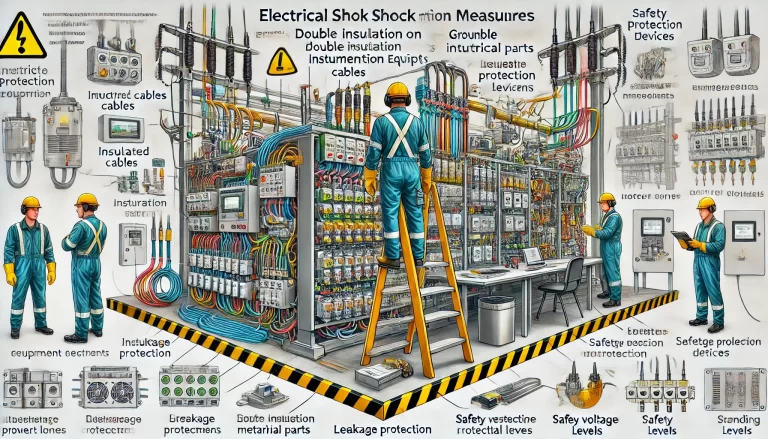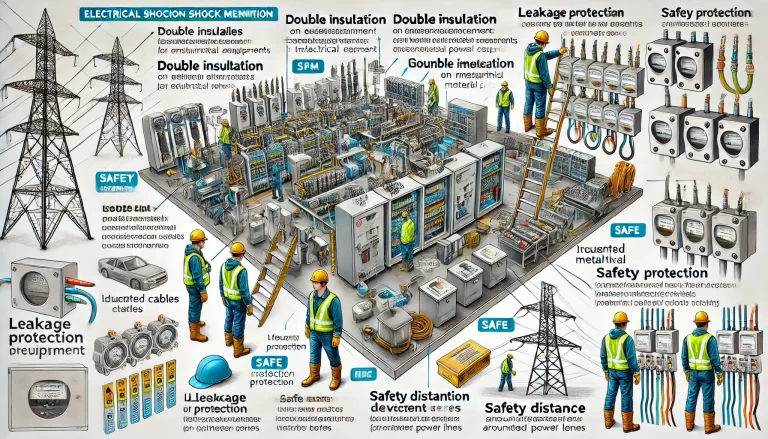During the installation, operation, and maintenance of instrumentation equipment, electrical shock prevention is a common and critical safety measure. Electrical shock protection refers to preventive measures taken to safeguard human life from electrical accidents that may result from improper operation, equipment failure, or excessive voltage. The consequences of electrical shocks are often severe, ranging from damage to instrumentation systems and hardware to injuries or even fatalities.
1. Indirect Electrical Shock Protection Measures
To protect against electrical shocks caused by indirect contact, safety measures can be implemented in several ways. These measures typically include protecting exposed conductive parts of electrical equipment that could become live during faults, applying double insulation or reinforced insulation, and using appropriate grounding methods. Below are the key protection techniques:
(a) Double Insulation and Reinforced Insulation
- Double Insulation: This involves the use of two layers of insulating materials to prevent direct contact with live electrical parts. It is especially important in devices that don’t have a direct connection to the earth (i.e., they are not grounded). Double insulation must meet specific resistance requirements:
- Working insulation: Minimum resistance of 2 MΩ.
- Protective insulation: Minimum resistance of 5 MΩ.
- Reinforced insulation: Minimum resistance of 7 MΩ.
- Marking of Equipment: For equipment with double or reinforced insulation, it must be clearly marked with the appropriate symbol, indicating that it does not require grounding.
(b) Grounding and Earthing Systems
- Protective Grounding: This is achieved by connecting the metal parts of equipment to the earth, which prevents electrical shock by reducing the potential difference between live parts and the ground.
- Protective Earthing (PE) and Neutral Connection: This system helps return leakage current safely to the power source, thereby avoiding electrical accidents during a fault.
- Working Grounding: This method ensures proper grounding of devices and systems for their stable operation and prevents unwanted electrical shocks during use.
While protective grounding, earthing, and working grounding are essential for electrical safety, their applications vary. Protective grounding is commonly used in low-voltage systems, while working grounding is tailored to specific equipment requirements.

2. Direct Electrical Shock Protection Measures
Direct electrical shock protection focuses on preventing human contact with live parts of electrical systems. The primary factors influencing this protection include the use of insulating materials, protective covers, and maintaining safe distances between electrical components.
(a) Insulating Materials
- Types of Insulating Materials: The classification and quality of insulating materials play a crucial role in preventing direct electrical shocks. Properly selected materials must ensure complete isolation from live electrical components.
- Material Performance: The materials used for insulation must resist wear and tear and be capable of withstanding environmental factors such as heat, moisture, and mechanical stress.
(b) Protective Barriers (Screens)
- Protective Covers: Devices such as enclosures, barriers, and protective covers can effectively isolate live components from human access. These barriers should meet the following requirements:
- Indoor barriers should be at least 1.2 meters high, while outdoor barriers should be no less than 1.5 meters.
- Covers should be installed securely, with a minimum height of 1.7 meters.
- Metallic barriers should be grounded to avoid any risk of electrical shock.
(c) Safety Distances
- Safe Clearance for Overhead Lines: To avoid electrical shocks from overhead power lines, clearances between lines and structures should be maintained:
- The distance between power lines and any combustible materials must be adequate to prevent fire hazards.
- Safety distances should also be observed to prevent “step potential” in case of a fault condition.
3. Combined Protection Measures for Direct and Indirect Contact
Combined protection measures utilize a combination of safety voltages and leakage protection devices. These methods ensure the overall safety of workers interacting with electrical systems.
(a) Safe Voltage Levels
- By limiting the voltage levels that could potentially come into contact with the human body, the resulting current can be kept within safe limits to reduce the risk of electrical shock.
- For instance, voltage levels exceeding certain thresholds (e.g., 50V for low-voltage systems) should be avoided.
(b) Leakage Protection
- Leakage Protection Devices: These devices are used to prevent both indirect and direct electrical shocks. They are essential in minimizing risks associated with leakage currents and preventing accidents.
- Types of Leakage Protection: Leakage protectors are available in various types, including voltage-type and current-type. The current-type protectors are particularly sensitive and act quickly to disconnect faulty systems, preventing further injury.
- Current Thresholds: Most leakage protection devices should have a low trip threshold (30mA) to ensure rapid disconnection during an electrical fault.
4. Installation, Operation, and Maintenance Safety Measures
Electrical shock prevention begins with a comprehensive safety strategy that integrates proper equipment selection, insulation, grounding, and operational safety procedures.
(a) Installation Safety
- Selecting Safe Equipment: Ensure all equipment meets the relevant safety standards, with complete protective features like insulation and grounding.
- Insulation Protection: For equipment that may be in contact with live parts, adequate insulation measures must be taken.
- Environmental Assessment: Assess the working environment for any potential electrical hazards and implement preventive measures accordingly.
- Proper Grounding: All devices must be properly grounded to reduce electrical shock risks during operation.
(b) Operational Safety
- Operating Standards: Develop and follow strict operating procedures to ensure safe use of electrical equipment, especially for maintenance staff.
- Regular Inspections: Conduct routine inspections to detect any faults, leakage issues, or wear and tear that could lead to electrical hazards.
- Warning Signage: Place clear warning labels in hazardous areas, and ensure personnel are aware of the risks and precautions.
- Personal Protective Equipment (PPE): Employees should wear appropriate PPE, including insulated gloves, shoes, and anti-static clothing.
(c) Maintenance Safety
- Power Shutdown During Maintenance: Always ensure that power is turned off when conducting maintenance, and verify that equipment is not live before starting work.
- Check Cables and Wires: Inspect cables and electrical wiring regularly for any signs of damage or degradation, and replace them as necessary.
- Qualified Personnel: Ensure that all maintenance work is carried out by qualified individuals with sufficient electrical safety training.
- Correct Tools: Use proper insulated tools when handling electrical components, and avoid the use of metal tools that may accidentally come into contact with live parts.

5. Training and Awareness
Electrical safety also relies on training and increasing awareness among workers. This can be achieved through:
(a) Safety Training Programs
- Conduct regular safety training sessions for employees, especially those directly involved in equipment installation, operation, and maintenance.
- Equip employees with the knowledge to identify electrical hazards and act swiftly in case of an emergency.
(b) Raising Awareness
- Through ongoing education and awareness campaigns, ensure that all personnel understand the importance of electrical safety and adhere to the recommended preventive measures.
Conclusion
Electrical shock protection in instrumentation equipment is paramount throughout the installation, operation, and maintenance processes. To ensure safety, we must adopt a comprehensive approach that includes appropriate insulation, grounding, leakage protection, and safety measures during all phases of equipment use. Additionally, training and raising awareness among employees play a crucial role in minimizing electrical hazards. By following these safety protocols, we can significantly reduce the risk of electrical accidents, ensuring both personnel and equipment remain safe.
